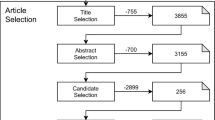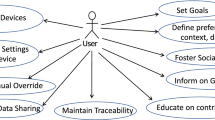Abstract
Quality requirements are the main drivers for modeling and evaluating software quality at an early stage, and ASPIRE is an engineering method designed to elicit and document the quality requirements of embedded systems. This paper proposes an extension to ASPIRE to identify quality requirements from the business goals of the organization and ensure their traceability. This extension includes a set of added components created from the main concepts of the SOQUAREM methodology, including the BMM (business motivation model), derivation rules, the quality attribute utility tree, the quality attribute scenario template, the quality attribute documentation template, and ISO 9126. The applicability of the extended method is illustrated with a wireless plant control system as an example.











Similar content being viewed by others
Notes
The term “NFR” is used in the ASPIRE method, while in this paper, we prefer to use the term “QR.”
References
Callele D, Penzenstadler B, Wnuk K (2013) Risk identification at the interface between business case and requirements. REFSQ’13 19th international conference on requirements engineering: foundation for software quality. Springer-Verlag Berlin, Heidelberg, pp. 253–268
Zowghi D, Coulin C (2005) Requirements elicitation: a survey of techniques, approaches, and tools. Engineering and managing software requirements. Springer Berlin Heidelberg, pp. 19–46. doi: 10.1007/3-540-28244-0_2
Al-Rawas A, Easterbrook SM (1996) Communication problems in requirements engineering: a field study. Cognitive science research papers, University of Sussex at Brighton, Brighton
Sajjad U, Qaisar HM (2010) Issues and challenges of requirement elicitation in large web projects. Master Thesis Computer Science Thesis no: MCS-2010:05, School of Computing Blekinge Institute of Technology, Ronneby, Sweden
Sommerville I (2006) Software engineering, 8th edn. Addison-Wesley Longman Publishing Co., Inc., Boston. ISBN 0321313798
Cysneiros LM, Sampaio do Prado Leite LC (2004) Non-functional requirements: from elicitation to conceptual models. IEEE Trans Softw Eng, 30(5):328–350, IEEE Press Piscataway, NJ, USA. doi:10.1109/TSE.2004.10
Bredemeyer D, Malan R (2001) Defining Non-functional requirements. Bredemeyer Consulting, White Paper. 8 p. http://www.bredemeyer.com. Accessed 19 Mar 2013
Chung L, Sampaio do Prado Leite LC (2009) On non-functional requirements in software engineering. Conceptual modeling: foundations and applications. Springer-Verlag Berlin Heidelberg, pp. 363–379. doi:10.1007/978-3-642-02463-4_19
Hill RL, Wang J, Nahrstedt K (2004) Quantifying non-functional requirements: a process oriented approach. 12th IEEE international conference on requirements engineering (RE), September 6-10, Kyoto, Japan, pp. 352–353
Wiegers K (1999) Writing QRs. process impact. http://www.processimpact.com/articles/qualreqs.html. Published in Software Development Magazine. Accessed 05 May 2013
Poort ER, de With PHN (2004) Resolving requirement conflicts through non-functional decomposition. 4th working IEEE/IFIP conference on software architecture (WICSA), 12–15 June Oslo, Norway, pp 145–154
Herrmann A, Paech B (2008) MOQARE: misuse-oriented quality requirements engineering. Requirements Eng J 13(1):73–86. Springer-Verlag New York, Inc. Secaucus, NJ, USA
Brito I, Moreira A, Araujo J (2002) A requirements model for quality attributes. Workshop on “early aspects: aspect-oriented requirements engineering and architecture design”, 1st international conference on aspect-oriented software development. 22–26 April University of Twente, Enschede, Holland, pp. 1–6
Jacobson I, Christerson M, Jonsson P, Övergaard G (1992) Object-oriented software engineering: a use case driven approach. Addison-Wesley, Wokingham, England
Trendowicz A, Punter T (2003) Quality modeling for software product lines. 7th ECOOP workshop on quantitative approaches in object-oriented software engineering, QAOOSE, Darmstadt, Germany
Chung L, Nixon BA, Yu E, Mylopoulos J (2000) Non-functional requirements in software engineering. Kluwer Academic Publishing
Doerr J, Kerkow D, Koenig T et al (2005) Non-functional requirements in industry: three case studies adopting the ASPIRE™ NFR method. 13th IEEE international conference on requirements engineering (RE), August 29–September 2, Paris, France, pp 373–384
Kerkow D, Kohler K, Doerr J (2003) Usability and other quality aspects derived from use cases. Performance by design. USE - second international conference on usage-centered design, October 18–22, Portsmouth, New Hampshire, pp 135–154
Doerr J (2011) Non-functional requirements. lecture: requirements engineering WS 2010/2011. http://www.agse.informatik.uni-kl.de/teaching/re/ws2010/Vorlesung%20RE_WS1011_NFR.pdf. Accessed 23 May 2013
Institute Experimentelles Software Engineering. http://www.iese.fraunhofer.de/index.jsp. Accessed 15 Oct 2013
Herrmann A, Weiß D (2009) Alignment of software specifications with quality-and business goals in the SIKOSA method. PRIMIUM: Process Innovation for Enterprise Software, Mannheim, pp 27–42
Djouab R, Suryn W (2011) SOQUAREM: software quality requirements engineering method. SQM conference on quality management. 18–20 Apr Loughborough University, Leicestershire, UK
ISO, IEC 9126–1 (2001) Software engineering: product quality—Part 1: quality model. International Organization for Standardization, Geneva
Azuma M (2004) Applying ISO/IEC 9126-1 quality model to QRs engineering on critical software. Sixth international workshop on requirements for high assurance systems (RHAS 2004), Kyoto, Japan, pp 3–10
ISO/IEC 25030 (2007) Software engineering—software product quality requirements and evaluation (SQuaRE)—quality requirements. International Organization for Standardization
Abran A, Bourque P, Dupuis R, Moore JW, Tripp LL (eds) (2004) Guide to the software engineering body of knowledge-SWEBOK. IEEE-CS Press, Piscataway
Campbell J (2007) Lecture 9, Part 2: Non-functional requirements. CSC340 - Winter 2007, University of Toronto. http://www.cdf.toronto.edu/~csc340h/winter/lectures/w10/L9-part2-6up.pdf. Accessed Aug 2014
Borg A (2004) Contributions to management and validation of non-functional requirements. Linköpings universitet, PELAB - Laboratoriet för programmeringsomgivningar, Linköpings universitet, Tekniska högskolan (författare), BokAvhandlingEngelska
Amyot D, Mussbacher G (2003) URN: towards a new standard for the visual description of requirements. Telecommunications and beyond: the broader applicability of SDL and MSC. Edel Sherratt (Ed.) SAM, Lecture Notes in Computer Science. 25(99):21–37
Castro J, Kolp M, Mylopoulos J (2002) Towards requirements-driven information systems engineering: the Tropos project. Inf Syst 27(6):365–389
Dutoit AH, Paech B (2002) Rationale-based use case specification. Requir Eng 7(1):3–19
Hill R, Wan J, Nahrstedt K (2004) Quantifying non-functional requirements: a process oriented approach. 12th IEEE international conference on requirements engineering. 6–11 Sept pp. 352–353
Rilston F, Paim S, Castro JFB (2002) Enhancing data warehouse design with the NFR framework. 5th Workshop on requirements engineering (WER2002), Valencia Spain, pp 11–12
Supakkul S, Chung L (2012) The RE-tools: a multi-notational requirements modeling toolkit. 20th IEEE International conference on requirements engineering. 24–28 Sept pp 333–334
Yrjönen A, Merilinna J (2009) Extending the NFR framework with measurable non- functional requirements. 2nd international workshop on non-functional system properties in domain specific modeling languages. Denver, Colorado, USA
Nasir MM, Arif M, Samina K, Tehmina K, Faisal MM (2009) Measurable and scalable NFRs using fuzzy logic and likert scale. International journal of computer science and information security (IJCSIS), 2(1). http://dblp.uni-trier.de/db/journals/corr/corr0906.html#abs-0906-5393. Accessed Aug 2014
Dewi M, Didar Z, Nurie N (2009) Managing conflicts among non-functional requirements. 12th Australian workshop on requirements engineering (AWRE ‘09), Sydney Australia
Davis AM (2003) The art of requirements triage. Comput J 363:42–49. IEEE Computer Society Press Los Alamitos, CA, USA. doi:10.1109/MC.2003.1185216
Boehm HI, Barry W, Rodgers TL, Deutsch M (2001) Applying win–win to quality requirements: a case study. 23rd International Conference on Software Engineering Toronto, Ontario, Canada IEEE Computer Society, pp 555–564
Saaty TL (1980) The analytic hierarchy process. McGraw-Hill, New York
Beck K (1999) Extreme programming explained. Addison-Wesley Longman Publishing Co., Inc., Boston
Egyed A, Grunbacher P (2004) Identifying requirements conflicts and cooperation: how quality attributes and automated traceability can help. IEEE Softw 21(6):50–58
Boehm HI, Barry W (1999) Cost versus quality requirements: conflict analysis and negotiation aids. Softw Q Prof 1(2):38–50
Glinz M (2007) On non-functional requirements. 15th IEEE international requirements engineering conference (RE). 15–19 Oct New Delhi, India, pp 21–26
Mylopoulos J (2004) Non-functional requirements, information systems analysis and design. http://www.cs.toronto.edu/~jm/340S/Slides2/NFR.pdf. Accessed Jan 2013
Gross D, Yu E (2001) Evolving system architecture to meet changing business goals: an agent and goal-oriented approach. 5th IEEE international symposium on requirements engineering (RE), 27–31 Aug Toronto, Canada, pp 316–317. doi:10.1109/ISRE.2001.948602
Punter T, Van Solingen R, Trienekens JM (1997) Software product evaluation: current status and future needs for customers and industry. 4th IT evaluation (EVIT-97), Delft, the Netherlands, pp 1–11
Carvallo JP, Franch X (2003) Using QMs in software package selection. IEEE Softw 20(1):34–41
Van Solingen R, Kusters RJ, Trienekens JM (1999) Identifying embedded software quality: two approaches. Q Reliab Eng Int 15(6):485–492. doi:10.1002/(SICI)1099-1638(199911/12)15:6<485:AID-QRE295>3.0.CO;2-3
Djouab R (2012) Software product quality requirements engineering method: SOQUAREM. Ph.D dissertation, École of Technologie Supérieure—Université du Québec, Montréal, QC, Canada
Djouab R, Suryn W (2007) Applicability analysis of two QRs treatment methods: ASPIRE and FDAF. International conference on software and systems engineering and their applications (ICSSEA), 4–6 Dec Conservatoire National des Arts et Métiers, Paris, France
Fagnani S (2014) What are business goals? eHow Contributor. http://www.ehow.com/facts_5758424_business-goals_.html#ixzz2zjhOx0Rc. Accessed April 2014
Kazman R, Bass L (2005) Categorizing business goals for software architectures. Technical report CMU/SEI- 2005-TR-021, Software Engineering Institute, Carnegie Mellon University. http://www.sei.cmu.edu/library/abstracts/reports/05tr021.cfm. Accessed May 2014
Weiß D, Leukel J, Kirn S (2008) A method for aligning business process modeling and software requirements engineering. PRIMIUM Subconference at the Multikonferenz Wirtschaftsinformatik (MKWI), (February 26–28, Garching, Germany). CEUR-WS.org CEUR Workshop Proceedings
Basili VR, Heidrich J et al (2013) Linking software development and business strategy through measurement. IEEE Comput 43(4):57–65. doi:10.1109/MC.2010.108
Bleistein SJ, Cox K, Verner J (2006) Validating strategic alignment of organizational IT requirements using goal modeling and problem diagrams. J Syst Softw 79(3):362–378
Bleistein SJ, Aurum A, Cox K, Ray PK (2004) Strategy-oriented alignment in requirements engineering: linking business strategy to requirements of e-business systems using the SOARE approach. J Res Pract Inf Technol 36(4):259–276
Morris PWG, Jamieson A (2005) Moving from corporate strategy to project strategy. Project Manag J. 36(4):5–18. ISSN 87569728
Clements P, Bass L (2010) Relating business goals to architecturally significant requirements for software systems. Technical note CMU/SEI-2010-TN-018 Research, Technology, and System Solutions Program
Business Rules Group (BRG) (2007) Business motivation model (Version 1.3). http://www.businessrulesGroup.org. Accessed April 2013
Zubrow D (2004) Software quality requirements and evaluation, the ISO 25000 series. PSM technical working group. Carnegie Mellon University. Pittsburgh, PA 15213-3890, 35 p. http://www.psmsc.com/Downloads/TWGFeb04/04ZubrowISO25000SWQualityMeasurement.pdf. Accessed Aug 2014
Kazman R, Klein M, Clements P (2000) ATAM: method for architecture evaluation. Technical report CMU/SEI-2000-TR-004. Software Engineering Institution, Carnegie Mellon University, Pittsburgh, PA, USA, 83 p
Author information
Authors and Affiliations
Corresponding author
Rights and permissions
About this article
Cite this article
Djouab, R., Abran, A. & Seffah, A. An ASPIRE-based method for quality requirements identification from business goals. Requirements Eng 21, 87–106 (2016). https://doi.org/10.1007/s00766-014-0211-1
Received:
Accepted:
Published:
Issue Date:
DOI: https://doi.org/10.1007/s00766-014-0211-1




